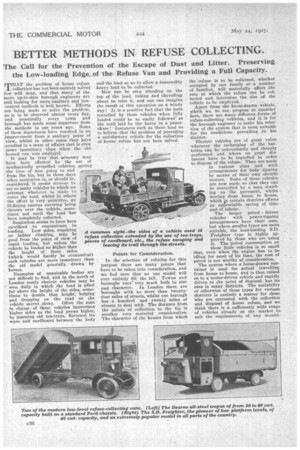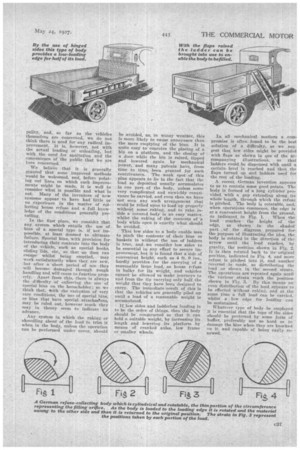BETTER METHODS IN REFUSE COLLECTING.
Page 94

Page 95

If you've noticed an error in this article please click here to report it so we can fix it.
The Call for the Prevention of the Escape of Dust and Litter. Preserving the Low-loading Edge_of the Refuse Van and Providing a Full Capacity.
TFIAT the problem of house refuse collection has not been entirely "solved feW will deny, and that many of the more up-to-date borough engineers are still looking for more sanitary and convenient methods is well known. Efforts are being made to solve the problem, as is to be observed almost every day, and practically every town and borough has made some departure from the methods in use years ago. Some of these departures have resulted in an improvement from a sanitary point of view, whilst in other cases they have resulted in a state of affairs that is even more insanitary than when the old horsed van was employel.
• It may be true that economy may have been effected by the use of mechanically propelled vehicles, saving the time of men going to and from the tip, but in these days when sanitation is, or should be, considered, it seems strange to see so ,many vehicles in which no attempt whatever is made to ; cover the load, whilst in others• the effort is very primitive, an ill-fitting canvas covering being thrown over the vehicle, sometimes not until the load has been completely collected.
Sanitation seems to have been sacrificed to convenience in loading. Low sides, requiring no ladder climbing, may be good from the point of view of rapid loading, but unless the vehicle be loaded no higher than the height of , these sides (which would hardly be economical) such vehicles are more insanitary than the old model generally drawn by horses.
Examples of unsuitable bodies are not difficult to find, and in the north of London costly electric vehicles may be seen daily in which the load is piled far above the height of the sides, sometimes to double that height, bulging and dropping on the road as the vehicle moves, along. Often the man in charge of these vehicles improvises higher sides as the load grows higher, by jamming old tea-trays, flattened tin ware and cardboard between the body
A co refus piece and the load so as to allow a reasonably heavy load to be collected.
Men can be seen standing on the top of the load, raking and shovelling about to trim it, and one can imagine the result of this operation on a windy day It is a positive fact that the path travelled by these vehicles -when fully loaded could be as easily followed" as the trail laid by the hares in a paperchase I Instances such as these lead us to believe that the problem of providing a satisfactory vehicle for the collection of house refuse has not been solved.
Points' for Consideration.
In the selection of vehicles for this purpose there are many points that have to be taken into consideration, and we feel sure that no one model will ever entirely fill the bill. Towns and boroughs vary" very much both in size and character. In London there are boroughs with no more than twentyfour miles of streets, whilst one borough has a hundred aid twenty miles of streets to deal with. The distance from the points of collection to the tip is another very material consideration. The character of the houses from which the refuse is to be collected, whether occupied by one family or a number of families, will materially affect .the rate at which the refuse can be collected and determine the size of the vehicle to be employed.
Apart from the horse-drawn vehicle, which we do not propose • to consider here, there are many different forms of refuse-collecting vehicles, and it is for the borough engineer to make his selection of the system that is most suitable for the conditions prevailing in his district.
Electric vehicles are of great value wherever the recharging of the batteries can be conveniently and cheaply performed and where no great distances have to be travelled in order to dispose of the refuse. They are made in various. sizes and with arrangements for body tipping by means of their own: electric motors. Some of these vehicles are now made so that they can be controlled by a man standing on the pavement, whilst moving from house to house, which n certain districts effects 7 an appreciable saving of time and of labour.
The larger petrol driven vehicles with power-tipping arrangements have their uses, but where smaller types are more suitable, the load-loading S.D. Freighter type is highly approved by those who are using it. The petrol consumption on these little vehicles is so small that, even when the engine has to be idling for most of its time, the cost of petrol is not worthy of consideration.
The system where a horse-drawn container is used for actual travelling from house to house, and is then raised on to a motor-driven vehicle and rapidly driven to the point of disposal, has its uses in many districts. The suitability or otherwise of these types for various districts is entirely a matter for those who are entrusted with the collection and disposal of house refuse, and we think there is a. sufficiently wide range of vehicles already on the market to suit the requirements of any munici
pality, 'and, so far as the vehicles themselves are . concerned, we do not think there is need for any radical improvement. It is, however, not with the actual loading or unloading, but with the need for sanitation and the convenience of the public that 'ire are fere concerned.
We believe that it is generally granted that some improved methods would be welcomed, and, before pointing out lines on which such improvements might he made, it is well to consider what is possible and what is not. Many of the inventors of new systems appear to have had little or no experience in the matter of collecting house refuse and a full knowledge of the conditions generally prevailing.
In the first place, we consider that any system which entails the use of bins of a special type is, if hot impossible, at least doomed to ultimate failure. Special bins, with provision for introducing their contents into the body of the vehicle, such as special hooks, sliding lids, etc., so that no dust can escape whilst being emptied, may work satisfactorily -when they are new, .but after a short period of use they will become damaged. through rough handling and will cease to function prop-erly. Apart from this, there is always the difficulty of enforcing the. use of Special bins on the householder ; so we think that, with the exception of very -rare conditions, the use of special bins, or bins that have special attachmAnts, may be ruled out, however much they may in theory seem to indicate an advance.
Any system in which the raking or shovelling about of the load to trim it when in the body, unless the operation can be performed under cover, should
be avoided, as, in wines weather, this is more likely to cause annoyance than the mere emptying of the bins. It is quite easy to conceive the placing of a bin on a platform, and the closing of a .door while the bin is raised, tipped and lowered again by mechanical power, and many patents have, from time to time, been granted for such contrivances. The weak spot of this plan appears to lie in the feet that the load so deposited usually accumulates in one part of the body, unless some very complicated and unwieldy contrivance be.carried, and even then we have not seen any such arrangement that -could be relied upon to load UP properly without some .raking, and to rake inside a Covered body is no easy 'matter, whilst the raking of the contents of -a body while open is exactly what should be avoided. .
That low sides to a body enable men to pitch the contents of their bins or baskets in without the use of ladders is true, and we consider low sides to be essential in any effort to secure improvement, but it is found that a Side of convenient height. such as 4 ft. 9 Ms., hardlY provides for the carrying of a reasonably large load, as house refuse in bulky for its weight, and vehicles cannot be allowed to make journeys to and from the tip carrying only ball the weight that they have been designed to carry. The immediate 'result of this is that the vehicles are generally piled up until a load of a reasonable weight is accumulated.
If, low sides and ladderless loading is to be the orderof things, then'tbe body should be constructed so that it can hold a suitable weight, by increasing its length and lowering its platform by means of cranked axles, low frame or smaller wheels. In all mechanical matters a compromise is often found to be the best solution of a difficulty, so we suggest that low sides might be provided with flaps as shown in kne of the accompanying illustrations, so that ladders could be dispensed with until certain level is reached and then the flaps turned up and ladders used for the rest of the loading.
A recent German invention appears to us to contain some good points. The body is formed of a long Cylinder provided with a gap extending .along its whole length, through which the refuse is pitched. The body is rotatable, and, when operations commence, the edge is at a convenient height. from the ground, as indicated in Fig. 1. When the load reaches the' height of the edge, as shown in the shaded part of the diagram prepared for the purpose of illustrating the idea, the body is rotated in the direction of the arrow until the load reaches, by gravity, the position shown in Fig. 2. It is then rotated back to its original position, indicated in Fig. 4, and more refuse is pitched intci it, and another reversal -.is made, so distributing the load as shown in the second strata. The operations are repeated again until the various _strata • reach the position shown in Viz .3. By this means an even distribution of the load anpearsto be effected without rakini.., mid at the same time a full load can be carried, whilst a low edge for loading can be maintained.
Whatever type of body -be employed it is essential that the tops of the sides should be Protected by some form of buffer, preferably not so hard as to damage the bins when they are knocked on it, and capable of being easily renewed.




















































































































































































